FOGO Frequently Asked Questions

Why doesn’t the City roll out kerbside recycling instead?
What does FOGO mean?
Why is the City conducting a FOGO trial?
What are the benefits of collecting FOGO waste?
Will there be an additional cost for FOGO?
Can I opt out of the trial?
We already have a compost system at home. Do I still need a FOGO bin?
What happens to my FOGO waste once it is collected?
What's new with my bin service?
When should I put out my FOGO bin for collection?
Will there be any changes to my regular rubbish pick up during the trial?
What can I put in my FOGO bin?
What cardboard can I put in the FOGO bin?
What cardboard products cannot be put into the FOGO bin?
What can’t go in the FOGO bin?
Why can’t animal faeces (poo) go into the FOGO bin?
Nappy Management
Is someone going to check what I throw into my FOGO bin?
What will happen if I accidentally throw the wrong thing into my FOGO bin?
Can my neighbour throw their FOGO waste in my bin too?
What is the small bin (kitchen caddy) that has been delivered for?
Is there a difference between recycled, biodegradable and compostable bags?
Where can I get more compostable liners for my kitchen caddy?
How can I make my compostable liners last longer?
How can I reduce the smell in my 240L FOGO bin?
I have seen people looking in my bins. What are they looking for?
How were households selected for the trial?
I have long service leave and will be going away for six months. Will I still have to take part in the trial?
My circumstances make it difficult to separate my waste properly. Can alternative services be made available?
Are there any places locally where I can recycle my waste?
Is the trial being rolled out to businesses?
I am not in the trial. Will I eventually get a new FOGO bin too?
Who owns the FOGO Bin?

Why doesn’t the City roll out kerbside recycling instead?
Latest reports are stating that only 9% of Australia’s plastics are being recycled.
Early last year, China, and more recently some south east Asian countries, began restricting the import of plastics, textiles and mixed paper due to high contamination rates which has caused a national recycling crisis. Cities across Australia that have introduced recycling schemes are now struggling to cope with their waste since China and now other south east Asian countries have stopped importing our recyclable waste. As a result, some Councils across Australia particularly the Eastern States are now dumping their recyclables into landfill as there is no longer a market for them and stockpiling combustible materials can be dangerous and bad for the environment. In late 2019 the State has released its Waste Avoidance and Resource Recovery Strategy 2030 which will give the City an opportunity to re-examine the implementation of kerbside recycling in order to ensure it align with the States Waste Strategy objective and targets. More here
What does FOGO mean?
FOGO stands for Food Organics Garden Organics and refers to the weekly collection of food scraps, as well as natural material from your garden to create high quality compost. A handy way to think about FOGO is ‘If it didn’t grow, or it wasn’t alive it’s not FOGO’.
Why is the City conducting a FOGO trial?
There are a number of reasons why the City is conducting a FOGO trial and these reasons are outlined below:
- City waste audits and the waste audits of other similar local governments show that a significant portion of the rubbish in our bins is made up of FOGO waste.
- The aim of the trial is to reduce waste to landfill and recover FOGO waste for processing.
- FOGO waste can be processed and the end material used locally rather than being sent to Perth or Overseas.
- The Western Australia State Strategy waste recovery target is set to increase municipal solid waste material recovery by 50% by 2020.
What are the benefits of collecting FOGO waste?
- The recovery of a lost resource. FOGO waste can be turned into compost and on-sold to reduce costs.
- Locally processed product that can returned to the local community.
- Reduction in methane gas emissions, which are 25 times more harmful to the environment than CO2 gas, from FOGO waste rotting in landfill.
- Proactively managing waste to minimise impact on the environment.
- Extend the life of landfill space at the Meru Waste Facility.
Will there be an additional cost for FOGO?
There will be no additional costs for households participating in the trial.
Can I opt out of the trial?
Participants won’t have the option to opt out of their trial and return the bin. We are encouraging all households in the trial to participate to the best of their ability. It is envisaged, dependent on the result of the trial, that moving forward a two-bin service will potentially become the standard service for City residents. Residents are welcome to contact the City and discuss any concerns or restrictions that might prevent you from fully participating in the two-bin system.
We already have a compost system at home. Do I still need a FOGO bin?
We encourage you to continue to compost at home, however you can use your lime green-topped FOGO bin for things you cannot put in your home compost bin such as bones, meat and seafood, paper and cardboard. As this is a trial, please keep the bin until your new service has settled. If you are still not using the bin after a period of time contact the City on 9956 6600 or email council@cgg.wa.gov.au and a Waste Officer will look into a solution for you.
What happens to my FOGO waste once it is collected?
The contents of your lime green-topped FOGO bin will be composted at the Meru Waste Facility.
What's new with my bin service?
Your household will soon have two separate bins: one for general waste and a FOGO bin. You will receive a new 240-litre lime green-lidded FOGO bin for all your food scraps and garden clippings, which will be collected on the same day as your regular rubbish bin during the trial and turned into high-quality compost.
When should I put out my FOGO bin for collection?
Your FOGO bin should be put out on the kerb on the same day as your general rubbish bin. Please ensure both bins are on the kerb before 6am on your rubbish collection day.
Will there be any changes to my regular rubbish pick up during the trial?
At the start of trial, your general waste pick up day will remain unchanged. However, after four weeks, your general waste will only be picked up every fortnight. As FOGO waste makes up approximately 50% of the rubbish in our bins, moving to a fortnightly pick up should not result in overflowing bins. Before the fortnightly pick up comes into place, your will receive a reminder notification from the City. We have also included a FOGO Collection Schedule in your information packet that shows which week the fortnightly pick up of your general waste rubbish bin will start taking place. Should you experience difficulty with the fortnightly pick up or require assistance please call 9956 6600 or email council@cgg.wa.gov.au
What can I put in my FOGO bin?
All food organics including meat and bones, fish and shellfish, grains and pasta, eggs and shells, fruit and vegetable scraps, coffee and tea, dairy products, plate scrapings, paper products such as tissues and paper towels, food-soiled products such as pizza boxes, shredded paper, timber shards, garden vegetation and compostable bags. Newspaper type junk mail, similar to the Bunnings advertisements, can also be placed in the bin. Please rip or shred these first for ease of processing. The contents of the FOGO bin will be composted so it is important only kitchen and/or organic waste goes into this bin. Please refer to the FOGO Bin Guide below on your kitchen caddy or visit the City’s website www.cgg.wa.gov.au
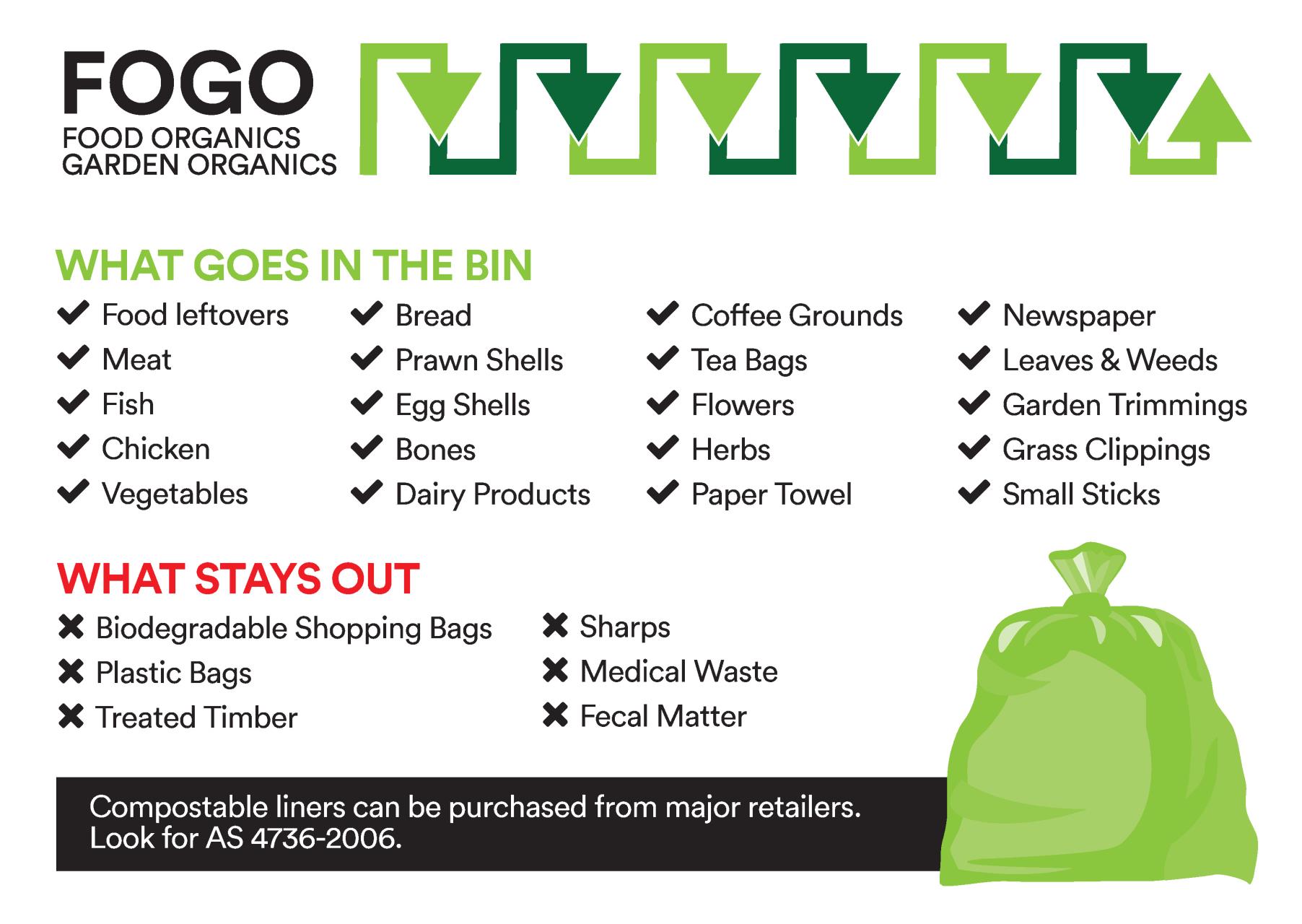
What cardboard can I put in the FOGO bin?
- Non-glossy cardboard
- Printed non-glossy cardboard
- Egg cartons
What cardboard products cannot be put into the FOGO bin?
- Glossy cardboard (this has a plastic coating on the outside and is not suitable for FOGO)
- Cardboard drink containers (including UHT milk, juice, plain and flavoured milk) – despite looking like a recyclable product, these containers have a hidden plastic lining.
What can’t go in the FOGO bin?
All plastics including bags and packaging materials, ceramics or glass, clothing or textiles, treated timber products, recyclable items, rocks, bulk sand, animal faeces (poo) and all general rubbish. All glossy junk mail is also not allowed in the FOGO bin. The contents of the FOGO bin will be composted so it is important to keep all plastic and glass out of this bin. Please refer to the FOGO Bin Guide on your kitchen caddy.
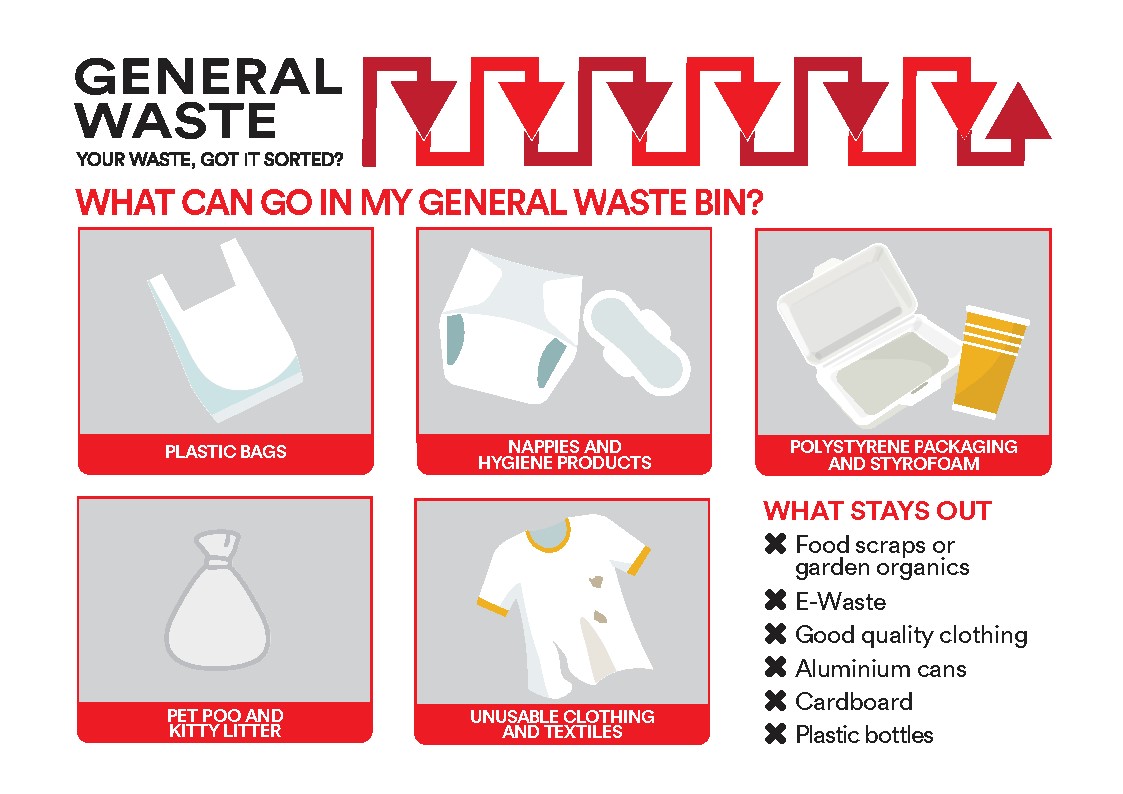
Why can’t animal faeces (poo) go into the FOGO bin?
Due to the risk of spreading infectious diseases, animal poo from household pets cannot be disposed of in the FOGO bin.
Nappy Management
Nappies must be placed in the red lidded General Waste bin. Although nearly all bins smell a bit, particularly bins containing nappies, did you know research has shown that nappies smell progressively worse for four days and then do not smell any worse (or better) after that? A waste bin containing nappies smells no worse after 14 days than after 7 days! Here are a number of things you can do to reduce the odour in your bin:
- Wrap the nappy into itself using the tabs.
- Seal nappies tightly in plastic bags (try scented bags) before disposing.
- If possible, consider tipping the contents of the nappy down the toilet before disposing.
- Store your rubbish bin in the shade and out of direct sun if possible.
- Make sure your bin lid closes properly and there are no cracks in the bin sides.
- Consider using odour neutralising products in the bin, such as cat litter or bicarbonate soda.
- Reusable cloth nappies are a great option. Whether using them part-time or full-time, they can help to save space and reduce odours in the garbage bin.
Is someone going to check what I throw into my FOGO bin?
Yes, part of the FOGO trial involves monitoring the content of FOGO bins for contamination and to record how people are using their new bins. Following a quick visual check of your bin, a tag will be placed on the handle of the bin, which will provide feedback about how well you are using the bins or what you can improve on.
What will happen if I accidentally throw the wrong thing into my FOGO bin?
If you notice you have thrown the wrong thing into the bin before it is collected please remove it and place in your general waste bin as throwing non-FOGO matter into the FOGO bin will result in the bin’s contents going to landfill rather than being used to make compost. Participants will be provided with feedback about how well they are using the bins or what they can improve upon via a tag placed on the handle of the bins as part of the bin-monitoring program. After two weeks of monitoring the contamination level of the FOGO bin, any bins found to have high levels of contamination will be taped up and the households requested to rectify the contamination before the bin is picked up the following week.
Can my neighbour throw their FOGO waste in my bin too?
No, they shouldn’t. Part of the trial includes providing feedback to individual households about how well they are using their FOGO bin and what they can improve upon. As the amount of FOGO waste collected will also be monitored, the addition of waste from other households could produce misleading results.
What is the small bin (kitchen caddy) that has been delivered for?
Each trial participant receives a free kitchen caddy to be utilised in the kitchen to help you separate your waste and to place your food scraps in. Your kitchen caddy will come with compostable liners that are suitable for your FOGO bin. Alternatively, you can also line your bin with old newspaper or place the food scraps in loosely. If you did not receive a kitchen caddy, please contact 9956 6600 and we will put you in touch with a Waste Officer who can assist you.
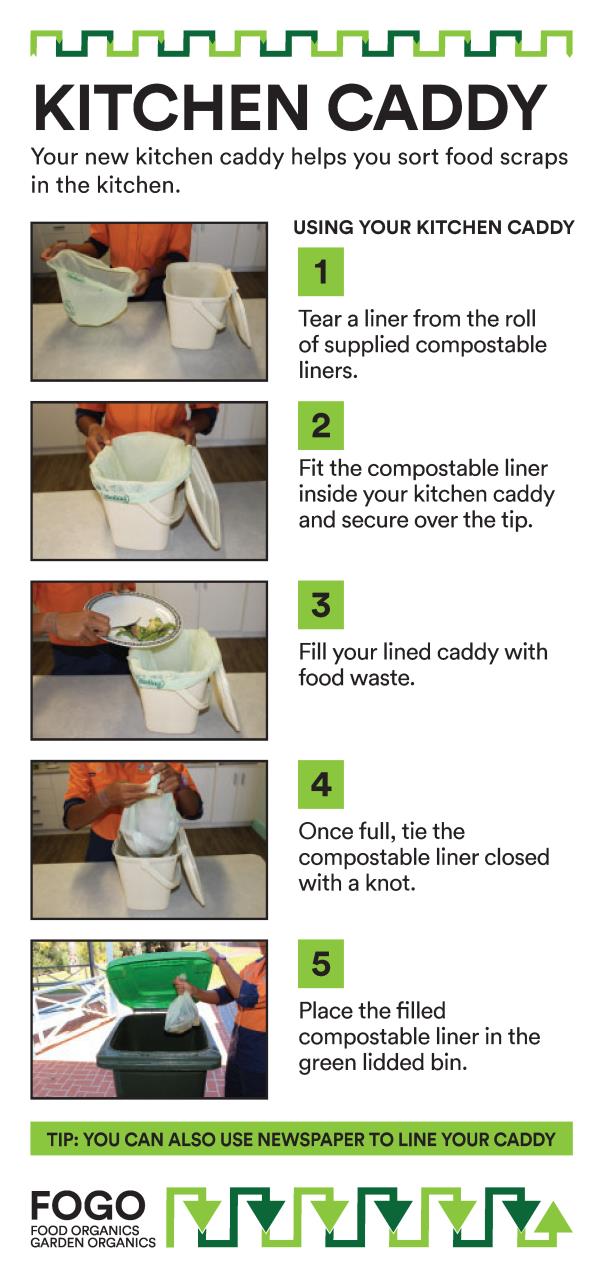
Is there a difference between recycled, biodegradable and compostable bags?
Yes, recyclable, biodegradable and compostable are often used interchangeably but they do not mean the same thing.
The term biodegradable actually doesn’t mean anything because everything is biodegradable eventually. Using the term biodegradable to describe plastic bags implies the plastic will decompose when it becomes waste. Although some bags labelled ‘green and degradable’ or ‘naturally degradable’ contain a chemical additive which makes them break down faster into smaller micro plastic fragments they are still made from normal plastic (polyethylene) so they are not in fact ‘green’ at all. They also don’t fully decompose in landfill because the required oxygen to decompose the product is too low nor does the process to create compost generate enough heat to decompose the plastic
Recyclable bags are also made from normal plastic (polyethylene) so they are basically the same as biodegradable bags. They will only break down into smaller micro plastic fragments if they contain a chemical additive triggered by oxygen or heat and therefore do not fully decompose in landfill.
Compostable bags on the other hand are often made from farmed products such as cornstarch, which means the bag can break down into carbon dioxide, water, inorganic compounds and biomass in about 90 days. This rate is similar to items you might see in backyard compost such as leaves and paper. Compost works because millions of tiny microbes consume the waste and transform the organic material into compost.
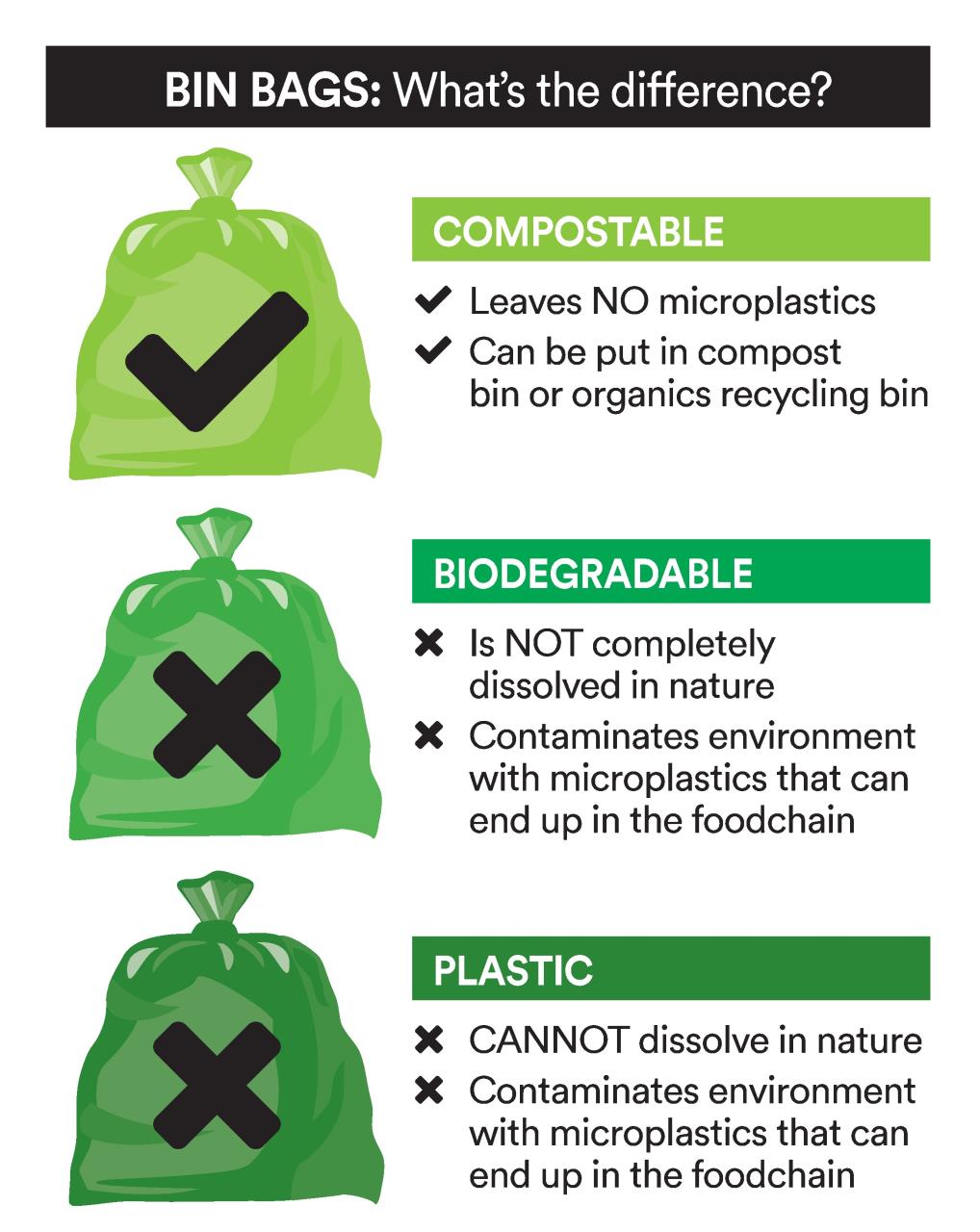
Where can I get more compostable liners for my kitchen caddy?
Coles, Woolworths, IGAs and Cleanpak Total Solutions sell compostable bin bags. They are also available at the Bower Bird (formerly Tip Shop) located at the entrance to the Meru Waste facility. Please note it is really important that only compostable liners be used to collect food organics as other materials will contaminate the FOGO bin and produce contaminated compost. Please refer to the kitchen caddy flyer for a list of compostable liners that should be used.
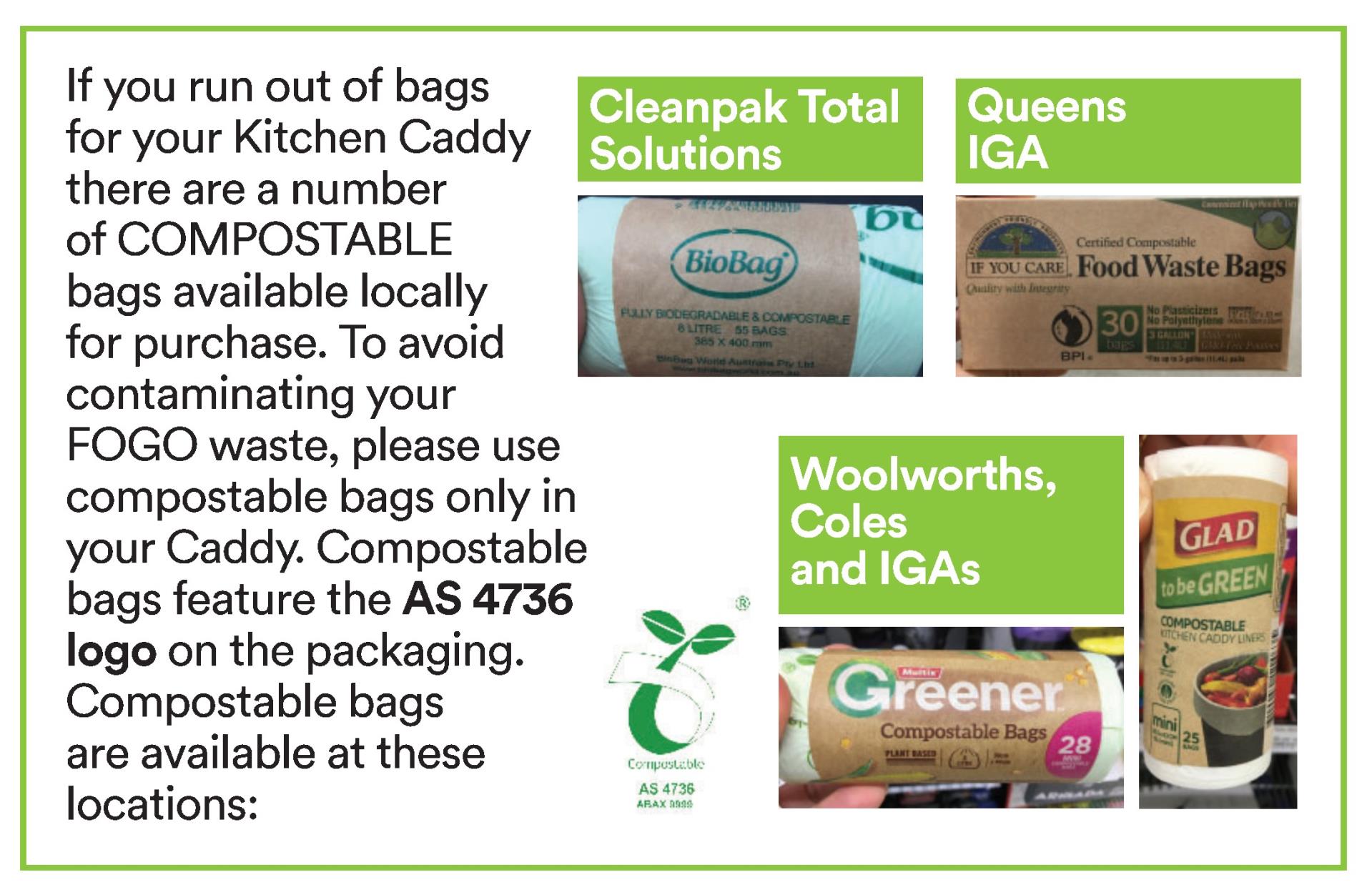
How can I make my compostable liners last longer?
Depending on the amount of food scraps you have, liners can last up to four days. When you need to change the liner, simply tie up and place in your FOGO bin.
Moisture can make them compost faster, so place newspaper or used paper towel at the bottom of your liner if your food scraps are wet. Store your liners in a cool and dry spot away from heat and sunlight.
How can I reduce the smell in my 240L FOGO bin?
The following methods may help reduce the smell in the FOGO bin:
- Using compostable liners
- Wrapping food scraps in newspaper
- Layering the food between layers of grass clippings and paper
- Freeze particularly odorous food scraps (eg. Seafood) and put them in the bin the night before collection
- Keep your bin in the shade with lid closed
- Try sprinkling bicarb soda, clean kitty litter, vinegar, oil of cloves or lemon juice after emptying
- Try a bin deodoriser
- Wash your bin regularly to remove any residue that may build up in the bottom of the bin
- Ensure you put your bin out for collection every week, even if there is only a small amount in the bin
I have seen people looking in my bins. What are they looking for?
Part of the FOGO trial involves monitoring the content of FOGO bins for contamination and to record how people are using their new bins. Following a quick visual check of your bin, a tag will be placed on the handle of the bin which provides feedback about how well you are using the bins or what you can improve on.
How were households selected for the trial?
The 500 households from across the City were randomly selected to provide a relevant demographic cross section of households. The aim is to understand households’ behaviours from across different sections of the community, which will provide relevant data to make informed predictions on how the behaviour of the wider community should the program eventually be rolled out to all households.
I have long service leave and will be going away for six months. Will I still have to take part in the trial?
Please contact the City on 9956 6600 to discuss a solution for this matter.
My circumstances make it difficult to separate my waste properly. Can alternative services be made available?
We understand that in some circumstances, residents may require special services. Please call 9956 6600 to discuss what solutions can be provided.
Are there any places locally where I can recycle my waste?
The City offers a variety of drop-off recycling and reuse options for residents who wish to recycle. A full list of the items that can be recycled, ranging from aluminium cans to waste oil, and where they can be recycled is available on the City website www.cgg.wa.gov.au search ‘Recycling’.
Is the trial being rolled out to businesses?
Mid 2020, Geraldton food businesses were invited to take part in the trial. Expression of Interest Currently, ten businesses are participating in the trial to assist the City produce a healthy compost product. Other commercial premises will have access to FOGO once the program is rolled out City wide.
I am not in the trial. Will I eventually get a new FOGO bin too?
The trial is anticipated to take around twelve months. Following this period, and dependent on the results of the trial, the City will decide whether to roll the service out to all residents. We understand you may be excited about the trial, however we have to test the service first to make sure it’s right for everyone.
Who owns the FOGO Bin?
The new 240L lime green top FOGO bin is being gifted to residents in the FOGO Trial. During the trial, the property owner or resident will own the bin and it will be their responsibility to care for and maintain it. The bin will not be replaced by the City unless damage is caused by the contractor during servicing of the bin.